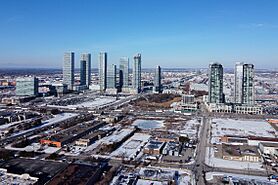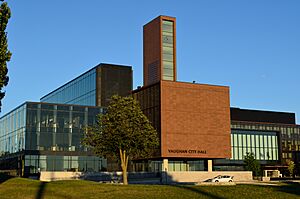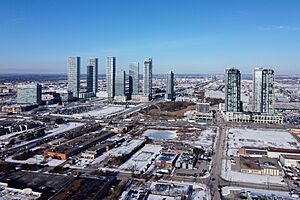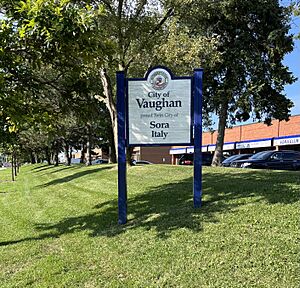Vaughan facts for kids
Quick facts for kids
Vaughan
|
|||||
|---|---|---|---|---|---|
| City of Vaughan | |||||
|
Vaughan Metropolitan Centre
View from Canada's Wonderland
Vaughan City Hall
MacMillan Yard
Vaughan Mills
|
|||||
|
|||||
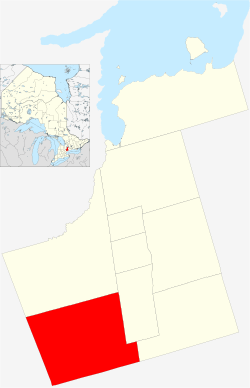
Location of Vaughan within York Region
|
|||||
| Country | Canada | ||||
| Province | Ontario | ||||
| Regional Municipality | York | ||||
| Communities |
List of major subdivisions
|
||||
| Settled | 1792 | ||||
| Incorporated | |||||
| • Township | 1850 | ||||
| • City | 1991 | ||||
| Government | |||||
| • Type | Municipal (City) | ||||
| Area | |||||
| • Land | 272.44 km2 (105.19 sq mi) | ||||
| Population
(2021)
|
|||||
| • Total | 323,103 (17th) | ||||
| • Density | 1,185.9/km2 (3,071/sq mi) | ||||
| • Total Private Dwellings | 107,159 | ||||
| Time zone | UTC-5 (EST) | ||||
| • Summer (DST) | UTC-4 (EDT) | ||||
| Area code(s) | 905, 289, 365, and 742 | ||||
Vaughan (pronounced "vawn") is a big city in Ontario, Canada. It's located just north of Toronto in the Regional Municipality of York. Vaughan grew very quickly between 1996 and 2006. Its population increased by over 80% in that time! It is now the fifth-largest city in the Greater Toronto Area and the 17th-largest city in all of Canada.
Contents
What's in a Name?
The city of Vaughan was named after Benjamin Vaughan. He was a British official who signed a peace treaty with the United States in 1783.
A Look Back: Vaughan's History
Long ago, the Huron-Wendat people lived in the area that is now Vaughan. One of their villages, Skandatut, was home to about 2,000 Huron people in the 1500s.
Early European Settlers
The first European to explore this area was a French explorer named Étienne Brûlé in 1615. However, it wasn't until 1792 that European families started to settle here. Back then, Vaughan was very remote and hard to reach because there were no proper roads.
Despite the challenges, many settlers came to Vaughan. By 1840, the population grew to 4,300 people. The first settlers were mostly Pennsylvania Germans, along with some English families and French Royalists. After 1814, more immigrants arrived from Britain. Many of these new arrivals were skilled workers, which helped the community grow.
Growing Communities
These early settlers created several small communities, also called hamlets. The oldest was Thornhill, where a sawmill was built in 1801. Other communities included Kleinburg, Maple, Woodbridge, and Concord. By 1846, Vaughan was mostly a farming area with a population of 4,300.
After World War II, many new immigrants came to Vaughan. By 1960, the population was nearly 16,000. People from different backgrounds, like Italians, Jews, and Eastern Europeans, began to make Vaughan their home.
Becoming a City
In 1850, Vaughan became a Township with its own local government. Later, in 1971, the Township of Vaughan joined with the Village of Woodbridge to form the Town of Vaughan. Then, in 1991, it officially became the City of Vaughan.
Tornadoes in Vaughan
On August 20, 2009, two strong tornadoes hit Vaughan. They caused a lot of damage to homes and trees. Many people were left without electricity. Luckily, no one died from the tornadoes. The community worked together to recover from the damage.
City Leadership
Vaughan is led by a council of ten members. This includes a mayor, four regional councillors, and five local councillors. The mayor is the head of the council. The regional councillors also serve on the larger York Region Council. The local councillors represent specific areas, called wards, within Vaughan.
The city council meets at Vaughan City Hall, which opened in 2011. This building is special because it was designed to be very environmentally friendly.
Vaughan was the first city in Ontario to have a Youth City Councillor. This young person is chosen every six months to represent the youth of Vaughan on the council. They don't vote, but they share important ideas from young people.
The current mayor of Vaughan is Steven Del Duca, who was elected in 2022.
Vaughan's Location and Areas
Vaughan is surrounded by other cities and towns. To the west are Caledon and Brampton. To the north are King and Richmond Hill. Markham and Richmond Hill are to the east. And to the south is Toronto.
Main Communities in Vaughan
Vaughan is made up of several historic communities. Many people identify more with these smaller communities than with the city as a whole. The city officially recognizes five main communities in its urban area:
- Woodbridge: Located between Major Mackenzie Drive and Steeles Avenue, and Highway 400 and Highway 50.
- Maple: Found between King Vaughan Line and Rutherford Road, and Bathurst Street and Highway 400.
- Thornhill: Stretches from Highways 7 and 407 (or Major Mackenzie west of Bathurst) down to Steeles Avenue, and from Yonge Street to Dufferin Street.
- Concord: Situated between Rutherford Road and Steeles Avenue, and Dufferin Street and Highway 400.
- Kleinburg: Lies between King Vaughan Line and Major Mackenzie Drive, and Highway 400 and Highway 50.
Vaughan Metropolitan Centre
The Vaughan Metropolitan Centre is a new city downtown area. It's being built around the intersection of Highway 7 and Jane Street. This area is planned to be a major hub for businesses and large commercial buildings.
The Vaughan Metropolitan Centre has its own subway station, which is the end of Line 1 Yonge–University of the Toronto subway system. It's also a big hub for local buses and rapid transit services.
Vaughan's Climate
Vaughan has a typical continental climate, meaning it experiences four distinct seasons: spring, summer, autumn, and winter.
| Climate data for Vaughan 1981–2010 (Woodbridge) | |||||||||||||
|---|---|---|---|---|---|---|---|---|---|---|---|---|---|
| Month | Jan | Feb | Mar | Apr | May | Jun | Jul | Aug | Sep | Oct | Nov | Dec | Year |
| Record high °C (°F) | 17.0 (62.6) |
15.5 (59.9) |
26.5 (79.7) |
31.5 (88.7) |
33.0 (91.4) |
36.0 (96.8) |
39.0 (102.2) |
37.2 (99.0) |
36.1 (97.0) |
30.6 (87.1) |
25.0 (77.0) |
19.5 (67.1) |
39.0 (102.2) |
| Mean daily maximum °C (°F) | −2.5 (27.5) |
−0.5 (31.1) |
4.3 (39.7) |
12.0 (53.6) |
18.8 (65.8) |
24.1 (75.4) |
26.9 (80.4) |
25.4 (77.7) |
20.9 (69.6) |
13.9 (57.0) |
6.9 (44.4) |
0.8 (33.4) |
12.6 (54.7) |
| Daily mean °C (°F) | −6.6 (20.1) |
−4.8 (23.4) |
−0.4 (31.3) |
6.6 (43.9) |
12.9 (55.2) |
18.1 (64.6) |
20.8 (69.4) |
19.6 (67.3) |
15.4 (59.7) |
9.0 (48.2) |
3.1 (37.6) |
−2.8 (27.0) |
7.6 (45.7) |
| Mean daily minimum °C (°F) | −10.7 (12.7) |
−9.2 (15.4) |
−5.2 (22.6) |
1.2 (34.2) |
6.8 (44.2) |
12.0 (53.6) |
14.7 (58.5) |
13.8 (56.8) |
9.8 (49.6) |
4.0 (39.2) |
−0.8 (30.6) |
−6.4 (20.5) |
2.5 (36.5) |
| Record low °C (°F) | −34.5 (−30.1) |
−30.0 (−22.0) |
−29.4 (−20.9) |
−17.2 (1.0) |
−6.7 (19.9) |
−1.7 (28.9) |
2.8 (37.0) |
−0.6 (30.9) |
−5.0 (23.0) |
−11.7 (10.9) |
−18.3 (−0.9) |
−30.0 (−22.0) |
−34.5 (−30.1) |
| Average precipitation mm (inches) | 50.3 (1.98) |
44.2 (1.74) |
49.2 (1.94) |
63.3 (2.49) |
79.1 (3.11) |
76.3 (3.00) |
70.4 (2.77) |
80.4 (3.17) |
84.6 (3.33) |
66.5 (2.62) |
78.3 (3.08) |
57.4 (2.26) |
799.8 (31.49) |
| Average rainfall mm (inches) | 20.4 (0.80) |
23.2 (0.91) |
31.4 (1.24) |
59.6 (2.35) |
79.1 (3.11) |
76.3 (3.00) |
70.4 (2.77) |
80.4 (3.17) |
84.6 (3.33) |
66.0 (2.60) |
71.1 (2.80) |
34.6 (1.36) |
697.0 (27.44) |
| Average snowfall cm (inches) | 29.9 (11.8) |
21.1 (8.3) |
17.8 (7.0) |
3.7 (1.5) |
0.0 (0.0) |
0.0 (0.0) |
0.0 (0.0) |
0.0 (0.0) |
0.0 (0.0) |
0.45 (0.18) |
7.2 (2.8) |
22.8 (9.0) |
102.8 (40.5) |
| Average precipitation days (≥ 0.2 mm) | 13.5 | 10.3 | 10.7 | 11.8 | 12.0 | 10.8 | 9.5 | 9.6 | 10.6 | 12.7 | 13.1 | 12.8 | 137.4 |
| Average rainy days (≥ 0.2 mm) | 4.2 | 4.4 | 6.4 | 10.7 | 12.0 | 10.8 | 9.5 | 9.6 | 10.6 | 12.6 | 11.1 | 6.5 | 108.3 |
| Average snowy days (≥ 0.2 cm) | 10.2 | 6.8 | 5.1 | 1.5 | 0.0 | 0.0 | 0.0 | 0.0 | 0.0 | 0.23 | 3.0 | 7.5 | 34.3 |
| Source: Environment Canada | |||||||||||||
City Services
Transportation in Vaughan
Vaughan has a well-developed transportation system. This includes major highways, public transit (buses), local roads, and train services.
People of Vaughan
| Historical populations | ||
|---|---|---|
| Year | Pop. | ±% |
| 1971 | 16,189 | — |
| 1976 | 18,120 | +11.9% |
| 1981 | 30,386 | +67.7% |
| 1986 | 67,595 | +122.5% |
| 1991 | 115,477 | +70.8% |
| 1996 | 132,549 | +14.8% |
| 2001 | 182,022 | +37.3% |
| 2006 | 238,866 | +31.2% |
| 2011 | 288,301 | +20.7% |
| 2016 | 306,233 | +6.2% |
| 2021 | 323,103 | +5.5% |
In 2021, Vaughan had a population of 323,103 people. The city covers an area of about 272.44 square kilometers. The average age of people in Vaughan in 2021 was 41.6 years old.
Languages Spoken
Vaughan is a very diverse city with many languages spoken. According to the 2021 Census, English is the main language spoken at home for 45.2% of residents. Italian is the second most common, spoken by 9.8% of the population. Other languages spoken by many residents include Russian, Mandarin, Spanish, and Persian.
Religions in Vaughan
As of 2021, most people in Vaughan identify as Christian (53.1%), with Catholicism being the largest group within Christianity. Other major religions include Judaism (13.2%), Islam (7.4%), and Hinduism (4.8%). About 17.0% of the population does not identify with a particular religion.
Ethnic Backgrounds
Vaughan is home to people from many different ethnic backgrounds.
| Ethnic Origin (2021) | Population | Per cent |
|---|---|---|
| Italian | 85,030 | 26.5 |
| Chinese | 27,235 | 8.5 |
| Jewish | 25,325 | 7.9 |
| Russian | 18,245 | 5.7 |
| Canadian | 17,780 | 5.5 |
| East Indian | 17,330 | 5.4 |
| Polish | 9,885 | 3.1 |
| Filipino | 9,140 | 2.9 |
| Portuguese | 8,300 | 2.6 |
| English | 8,265 | 2.6 |
| Vietnamese | 7,305 | 2.3 |
| Ukrainian | 7,080 | 2.2 |
| Iranian | 6,935 | 2.2 |
| Irish | 6,715 | 2.1 |
| Scottish | 5,895 | 1.8 |
Many residents of Vaughan belong to what are called "visible minority" groups, making up 35.4% of the population in 2021.
Culture and Fun
Attractions in Vaughan
Vaughan has many exciting places to visit:
- Canada's Wonderland: This is Canada's largest amusement park, full of thrilling rides and shows.
- Vaughan Mills: A huge shopping mall that also has the Legoland Discovery Centre.
- Reptilia Zoo: A large zoo dedicated to reptiles and amphibians.
- McMichael Canadian Art Collection: An art gallery in Kleinburg that focuses on Canadian art.
- Boyd Conservation Area and Kortright Centre for Conservation: These are great places to enjoy nature and learn about the environment.
- Baitul Islam Mosque: The main center for the Ahmadiyya Muslim community in Canada.
Sports in Vaughan
Vaughan is a very active city with many amateur sports teams. There are leagues for hockey, baseball, football, and basketball. Many youth teams represent the city, like the Vaughan Rangers (hockey) and Vaughan Vikings (baseball).
The city also has several golf and country clubs, including The National Golf Club of Canada, which is one of the top golf clubs in Canada.
Soccer in Vaughan
Soccer is very popular in Vaughan. Youth soccer programs are offered by Vaughan SC, Woodbridge SC, and Kleinburg Nobleton SC. Vaughan is also home to the Ontario Soccer Association, which is the largest sports organization in Canada. It has over 400,000 registered players! The Canadian Soccer Hall of Fame and Museum is also located here.
Media and Entertainment
Print Media
Vaughan has its own weekly newspaper called the Vaughan Citizen, which started in 2001. The Thornhill area has its own paper, the Thornhill Liberal. There are also other publications like Lo Specchio, an Italian-language newspaper, and City Life, a lifestyle magazine.
Filming Locations
Vaughan has been a filming location for movies and TV shows.
- The children's TV show The Forest Rangers was filmed in Kleinburg in the 1960s.
- The movie The Sentinel was filmed at the McMichael Art Gallery in 2006.
- More recently, Vaughan City Hall has been used as a set for popular shows like The Handmaid's Tale and Star Trek: Discovery.
Learning and Education
York University is a large university located very close to the Vaughan-Toronto border. It has over 55,000 students. A new York University School of Medicine is planned to open in Vaughan in 2028.
Vaughan has many elementary and high schools. These schools are part of different school boards, including the York Region District School Board (public schools) and the York Catholic District School Board (Catholic schools). There are also French-language public and Catholic schools.
Niagara University, a private Catholic university from the United States, has opened a branch campus in Vaughan. This is the first university campus in the city. It offers master's and bachelor's degree programs in education.
Vaughan's Economy
Vaughan is a very important economic center in the Greater Toronto Area. It's the third-largest place for jobs, after Toronto and Mississauga. In 2018, Vaughan's economy was worth $20.6 billion, making it the biggest contributor to York Region's economy.
In 2018, there were over 12,000 businesses in Vaughan, employing more than 222,000 people. The city's job and business growth have been faster than the rest of the province and country.
Manufacturing is a big part of Vaughan's economy, providing 22% of all jobs. Other important industries include construction, retail, wholesale trade, and transportation. Most businesses in Vaughan are small, with fewer than 20 employees.
Tourism is also important to Vaughan's economy. Major tourist spots like Canada's Wonderland, Vaughan Mills, and the McMichael Canadian Art Collection bring in a lot of visitors and money.
Major Employers and Companies
Some of the largest employers in Vaughan include:
Vaughan is also home to the Canadian or regional headquarters of many well-known companies, such as:
- Adidas Canada
- GFL Environmental
- Recipe Unlimited
- Toys "R" Us
Archaeological Discoveries
The Seed-Barker archaeological site in Vaughan is a 16th-century Iroquois village. Since 1976, high school students have visited this site as part of a summer school program. In the 1890s, a local farmer started finding Iroquoian artifacts here. Later, in the 1950s, university professors and students excavated many items. Since 1975, over a million artifacts have been found! They also uncovered nineteen longhouses, showing that the village was active from about 1500 to 1550 AD. The Iroquois people chose this spot because it had good land for farming corn, beans, and squash, which they called the "three sisters."
Famous People from Vaughan
Many notable people have come from Vaughan.
Order of Vaughan
In 2016, to celebrate the city's 25th anniversary, the "Order of Vaughan" award was created. This is the highest honor the city can give. It recognizes people who have made great contributions in areas like arts, sports, business, education, and public service.
Sister Cities
Vaughan has "twin cities" or "sister cities" around the world. These partnerships help promote cultural exchange and friendship.
- Sora, Italy (since 1992)
- Ramla, Israel (since 1993)
- Sanjō, Japan (since 1993)
- Yangzhou, China (since 1995)
- Baguio, Philippines (since 1997)
- Delia, Italy (since 1998)
- Lanciano, Italy (since 2002)
|
See also
 In Spanish: Vaughan (Ontario) para niños
In Spanish: Vaughan (Ontario) para niños


